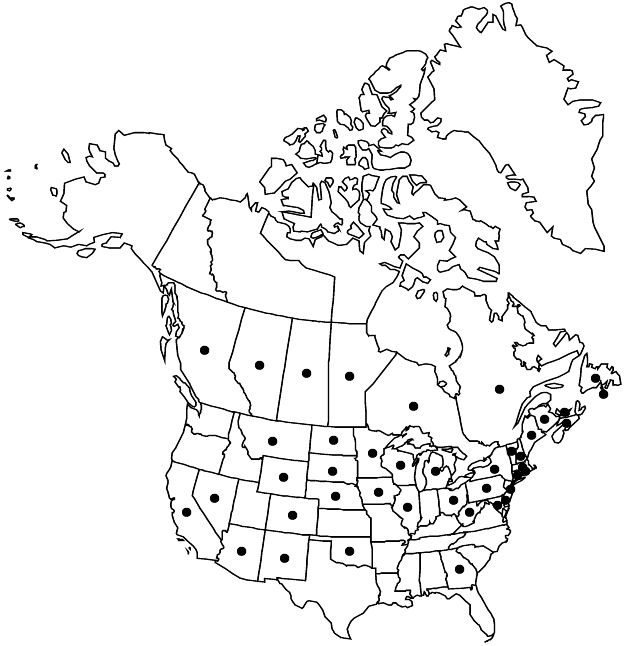Difference between revisions of "Agrimonia striata"
Fl. Bor.-Amer. 1: 287. 1803.
FNA>Volume Importer |
imported>Volume Importer |
||
| (5 intermediate revisions by 2 users not shown) | |||
| Line 10: | Line 10: | ||
|special_status={{Treatment/ID/Special_status | |special_status={{Treatment/ID/Special_status | ||
|code=F | |code=F | ||
| − | |label= | + | |label=Illustrated |
}} | }} | ||
|basionyms= | |basionyms= | ||
| Line 16: | Line 16: | ||
|name=Agrimonia brittoniana | |name=Agrimonia brittoniana | ||
|authority=E. P. Bicknell | |authority=E. P. Bicknell | ||
| + | |rank=species | ||
}} {{Treatment/ID/Synonym | }} {{Treatment/ID/Synonym | ||
|name=A. striata var. campanulata | |name=A. striata var. campanulata | ||
|authority=Fernald | |authority=Fernald | ||
| + | |rank=variety | ||
}} {{Treatment/ID/Synonym | }} {{Treatment/ID/Synonym | ||
|name=Eupatorium brittonianum | |name=Eupatorium brittonianum | ||
| − | |authority= | + | |authority= |
| + | |rank=species | ||
}} | }} | ||
|hierarchy=Rosaceae;Rosaceae subfam. Rosoideae;Rosaceae tribe Agrimonieae;Agrimonia;Agrimonia striata | |hierarchy=Rosaceae;Rosaceae subfam. Rosoideae;Rosaceae tribe Agrimonieae;Agrimonia;Agrimonia striata | ||
| Line 36: | Line 39: | ||
|habitat=Edges, open spaces, thickets, in deciduous or mixed deciduous woods | |habitat=Edges, open spaces, thickets, in deciduous or mixed deciduous woods | ||
|elevation=0–3700 m | |elevation=0–3700 m | ||
| − | |distribution=St. Pierre and Miquelon;Alta.;B.C.;Man.;N.B.;Nfld. | + | |distribution=St. Pierre and Miquelon;Alta.;B.C.;Man.;N.B.;Nfld. and Labr. (Nfld.);N.S.;Ont.;P.E.I.;Que.;Sask.;Ariz.;Calif.;Colo.;Conn.;Del.;Ga.;Ill.;Iowa;Maine;Md.;Mass.;Mich.;Minn.;Mont.;Nebr.;Nev.;N.H.;N.J.;N.Mex.;N.Y.;N.Dak.;Ohio;Okla.;Pa.;R.I.;S.Dak.;Vt.;W.Va.;Wis.;Wyo.;Mexico (Chihuahua;Distrito Federal;Hidalgo;Sinaloa;Sonora;Tamaulipas). |
|discussion=<p>Plants of <i>Agrimonia striata</i> with fruiting hypanthia campanulate or obconic or both occur throughout the range. Plants with vestiture more like that of <i>A. gryposepala</i> are sometimes found, particularly in Quebec and the mountains of Arizona and New Mexico.</p><!-- | |discussion=<p>Plants of <i>Agrimonia striata</i> with fruiting hypanthia campanulate or obconic or both occur throughout the range. Plants with vestiture more like that of <i>A. gryposepala</i> are sometimes found, particularly in Quebec and the mountains of Arizona and New Mexico.</p><!-- | ||
--><p><i>Agrimonia</i> eupatoria Linnaeus</p><!-- | --><p><i>Agrimonia</i> eupatoria Linnaeus</p><!-- | ||
| Line 50: | Line 53: | ||
-->{{#Taxon: | -->{{#Taxon: | ||
name=Agrimonia striata | name=Agrimonia striata | ||
| − | |||
|authority=Michaux | |authority=Michaux | ||
|rank=species | |rank=species | ||
| Line 60: | Line 62: | ||
|habitat=Edges, open spaces, thickets, in deciduous or mixed deciduous woods | |habitat=Edges, open spaces, thickets, in deciduous or mixed deciduous woods | ||
|elevation=0–3700 m | |elevation=0–3700 m | ||
| − | |distribution=St. Pierre and Miquelon;Alta.;B.C.;Man.;N.B.;Nfld. | + | |distribution=St. Pierre and Miquelon;Alta.;B.C.;Man.;N.B.;Nfld. and Labr. (Nfld.);N.S.;Ont.;P.E.I.;Que.;Sask.;Ariz.;Calif.;Colo.;Conn.;Del.;Ga.;Ill.;Iowa;Maine;Md.;Mass.;Mich.;Minn.;Mont.;Nebr.;Nev.;N.H.;N.J.;N.Mex.;N.Y.;N.Dak.;Ohio;Okla.;Pa.;R.I.;S.Dak.;Vt.;W.Va.;Wis.;Wyo.;Mexico (Chihuahua;Distrito Federal;Hidalgo;Sinaloa;Sonora;Tamaulipas). |
|reference=None | |reference=None | ||
|publication title=Fl. Bor.-Amer. | |publication title=Fl. Bor.-Amer. | ||
|publication year=1803 | |publication year=1803 | ||
| − | |special status= | + | |special status=Illustrated |
| − | |source xml=https:// | + | |source xml=https://bitbucket.org/aafc-mbb/fna-data-curation/src/2e0870ddd59836b60bcf96646a41e87ea5a5943a/coarse_grained_fna_xml/V9/V9_516.xml |
|subfamily=Rosaceae subfam. Rosoideae | |subfamily=Rosaceae subfam. Rosoideae | ||
|tribe=Rosaceae tribe Agrimonieae | |tribe=Rosaceae tribe Agrimonieae | ||
Latest revision as of 22:57, 5 November 2020
Herbs, 4–13 dm. Roots: tubers absent. Stems with ± glistening stipitate-glandular hairs and pubescent to pilose (at least distally) and hirsute (hairs scattered, erect, 2 mm, stiff). Leaves: mid cauline stipules ± falcate, margins proximally dentate or entire; major leaflets 3–11 (mid cauline 5–7), minor 1–4 pairs; major leaflet blades elliptic to rhombic, terminal largest, largest of these 4.3–10.7 × 1.9–4.2 cm, margins serrate, apex acute to acuminate or long-acuminate, abaxial surface with glistening glandular hairs (stipitate and sessile) and pubescent to pilose and hirsute (hairs stiff, scattered, 1–2 mm, densest along major veins). Inflorescences: axes with stipitate-glandular hairs and pubescent to pilose and hirsute (hairs stiff, scattered, proximally ± erect and 1–2 mm to distally ± ascending and 1 mm). Flowers usually ± subopposite. Fruiting hypanthia obconic to ± campanulate, rarely turbinate, 2.1–6.6 × 2.4–5.2 mm, deeply sulcate, hooked bristles in 3–4 circumferential rows, proximal row spreading ± 90º (pressed upward on dried specimens), stipitate-glandular hairs, ± glistening, grooves strigose, ridges usually sparingly hirsute (sepal bases usually pubescent along rim). 2n = 56.
Phenology: Flowering late Jun–Aug(–mid Sep).
Habitat: Edges, open spaces, thickets, in deciduous or mixed deciduous woods
Elevation: 0–3700 m
Distribution

St. Pierre and Miquelon, Alta., B.C., Man., N.B., Nfld. and Labr. (Nfld.), N.S., Ont., P.E.I., Que., Sask., Ariz., Calif., Colo., Conn., Del., Ga., Ill., Iowa, Maine, Md., Mass., Mich., Minn., Mont., Nebr., Nev., N.H., N.J., N.Mex., N.Y., N.Dak., Ohio, Okla., Pa., R.I., S.Dak., Vt., W.Va., Wis., Wyo., Mexico (Chihuahua, Distrito Federal, Hidalgo, Sinaloa, Sonora, Tamaulipas).
Discussion
Plants of Agrimonia striata with fruiting hypanthia campanulate or obconic or both occur throughout the range. Plants with vestiture more like that of A. gryposepala are sometimes found, particularly in Quebec and the mountains of Arizona and New Mexico.
Agrimonia eupatoria Linnaeus
Agrimonia eupatoria has been sporadically cultivated in the flora area. No evidence has been found that this introduced European species, which rarely escapes cultivation, has become an established element of the flora. It is distinguished from A. pubescens by the absence of tuberous roots, inflorescences with closely spaced, more or less subopposite flowers, and pendent fruiting hypanthia, 7–10 mm, covered with appressed hairs.
Agrimonia repens Linnaeus
Agrimonia repens has been reported (as A. odorata Miller) as persisting from cultivation on Prince Edward Island. There is as yet no evidence that this species is established; it can be identified by major leaflets more or less overlapping, mid cauline stipules 4–5 cm, petals 5–7 mm, and fruiting hypanthia cylindric with disc projecting 1.5 mm, 5–7 rows of circumferential bristles, proximal row reflexed.
Selected References
None.
